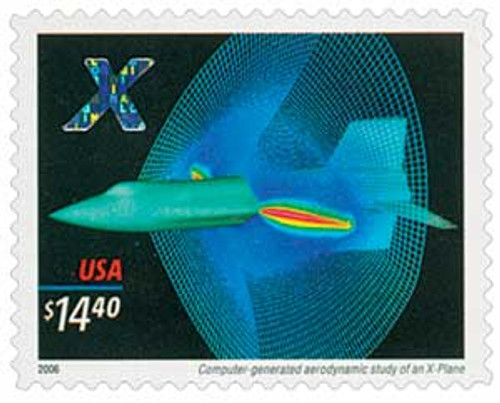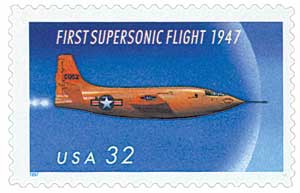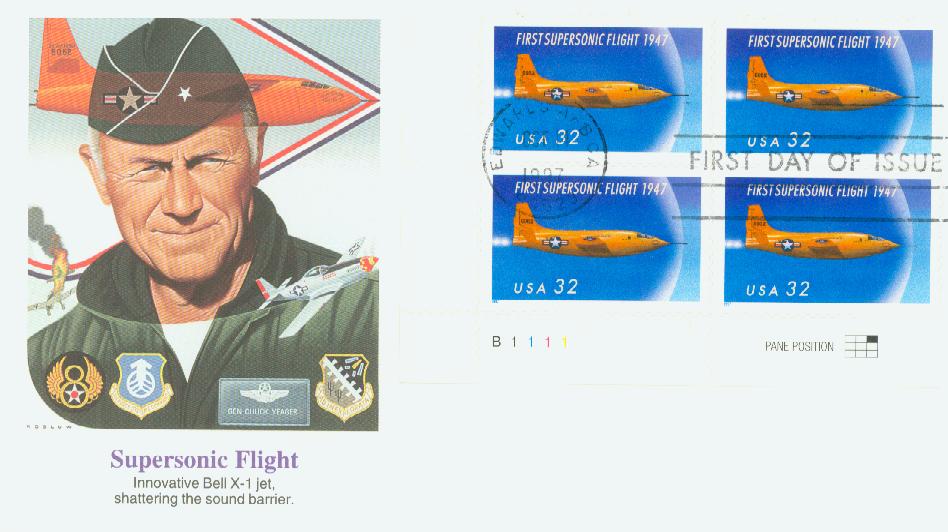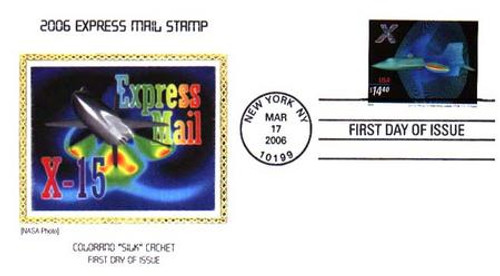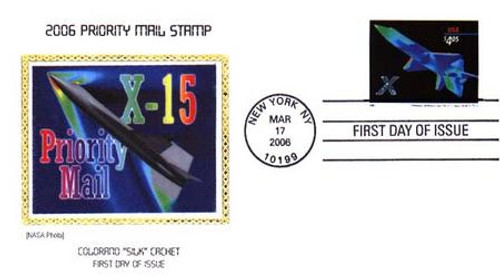
# 4019 - 2006 $14.40 X-Plane, Express Mail
2006 $14.40 X-Plane
Express Mail
City: New York, NY
First Supersonic Flight
Since the early 1940s, aviation scientists had been working to solve the problem of breaking the “sound barrier” – the sharp increase in aerodynamic drag that aircraft experience as they approach the speed of sound. For this purpose, the Bell Aircraft Company and the National Advisory Committee on Aeronautics built the rocket-powered Bell X-1.
To pilot the craft, the project’s planners selected Chuck Yeager. Born in 1923, Yeager flew 64 combat missions in World War II, claiming 12.5 aerial victories. After the war, Yeager had worked briefly as a flight instructor before taking a job as an assistant maintenance officer in the Flight Test Division. In that role, he got to fly nearly every fighter that came out of maintenance. Yeager’s flying skills were recognized and he was selected in 1946 to join a new test pilot school. After graduating, he was selected to pilot the X-1.
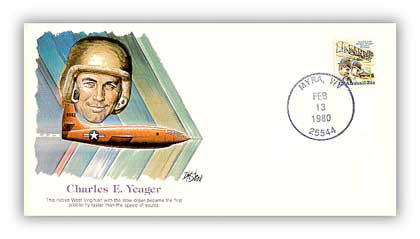
Yeager made his first test flight on August 29, 1947, reaching a speed of .85 Mach. In the following months, he made several other flights coming closer to his goal of Mach 1. Then, on October 14, 1947, Yeager was air-launched from under the bomb bay of a B-29 bomber. When Yeager reached 42,000 feet, he reached a speed of 700 miles per hour and accelerated past Mach 1 – the speed of sound. Due to the top-secret nature of the flight, his accomplishment was kept from the public until the following year.
Yeager continued to test new airplanes for the military until his retirement in 1975. That year, he was awarded a Congressional Medal of Honor for the part he played in breaking the sound barrier. In 2012, he flew in the back seat of an F-15 to re-enact his historic 1947 record.
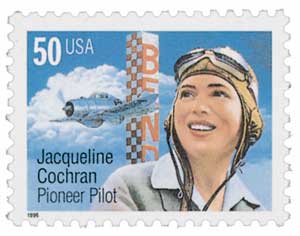
Six years after Yeager’s initial flight, Jacqueline Cochran became the first woman to break the sound barrier. She piloted a Canadian-built F-86 Sabre jet fighter on May 18, 1953.
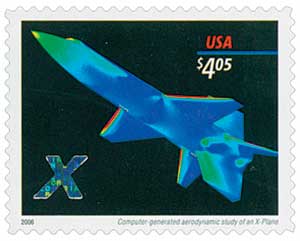
The Air Force would continue its experiments with hypersonic rocket-powered aircraft in the coming years. In 1959, the X-15 plane set a record that still stands today, as the fastest speed ever reached by a manned aircraft. The X-15 attained speeds of Mach 4, 5, and 6 – meaning it could fly up to six times the speed of sound…or more than 4,000 miles per hour!
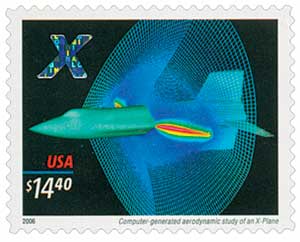
The X-15 was able to fly so high that it qualified as space flight. The US awards astronaut wings to anyone who exceeds an altitude of 50 miles, while the Fédération Aéronautique Internationale (the world body for aeronautics) considers the limit of space to be 100 km or 62.1 miles. The X-15 passed the 50-mile barrier 13 times, and the 62.1 barrier twice, flown by eight different pilots.
Yeager’s accomplishment was honored on a 1997 postage stamp (pictured above). The first-day ceremony for the stamp, commemorating the 50th anniversary of the flight, took place at Edwards Air Force Base, where the historic event happened.
The stamp includes microprinting for security. With a magnifying glass, “X-1” can be seen on the horizontal stabilizer on the tail and a row of three “USPS” is above the wing. Another microprinting caused controversy because on the nose of the plane is written: “Glamorous Glenna” a misspelling of Yeager’s plane “Glamorous Glennis,” named after his wife.
Click here to view video from Yeager’s historic flight.
2006 $14.40 X-Plane
Express Mail
City: New York, NY
First Supersonic Flight
Since the early 1940s, aviation scientists had been working to solve the problem of breaking the “sound barrier” – the sharp increase in aerodynamic drag that aircraft experience as they approach the speed of sound. For this purpose, the Bell Aircraft Company and the National Advisory Committee on Aeronautics built the rocket-powered Bell X-1.
To pilot the craft, the project’s planners selected Chuck Yeager. Born in 1923, Yeager flew 64 combat missions in World War II, claiming 12.5 aerial victories. After the war, Yeager had worked briefly as a flight instructor before taking a job as an assistant maintenance officer in the Flight Test Division. In that role, he got to fly nearly every fighter that came out of maintenance. Yeager’s flying skills were recognized and he was selected in 1946 to join a new test pilot school. After graduating, he was selected to pilot the X-1.

Yeager made his first test flight on August 29, 1947, reaching a speed of .85 Mach. In the following months, he made several other flights coming closer to his goal of Mach 1. Then, on October 14, 1947, Yeager was air-launched from under the bomb bay of a B-29 bomber. When Yeager reached 42,000 feet, he reached a speed of 700 miles per hour and accelerated past Mach 1 – the speed of sound. Due to the top-secret nature of the flight, his accomplishment was kept from the public until the following year.
Yeager continued to test new airplanes for the military until his retirement in 1975. That year, he was awarded a Congressional Medal of Honor for the part he played in breaking the sound barrier. In 2012, he flew in the back seat of an F-15 to re-enact his historic 1947 record.

Six years after Yeager’s initial flight, Jacqueline Cochran became the first woman to break the sound barrier. She piloted a Canadian-built F-86 Sabre jet fighter on May 18, 1953.

The Air Force would continue its experiments with hypersonic rocket-powered aircraft in the coming years. In 1959, the X-15 plane set a record that still stands today, as the fastest speed ever reached by a manned aircraft. The X-15 attained speeds of Mach 4, 5, and 6 – meaning it could fly up to six times the speed of sound…or more than 4,000 miles per hour!

The X-15 was able to fly so high that it qualified as space flight. The US awards astronaut wings to anyone who exceeds an altitude of 50 miles, while the Fédération Aéronautique Internationale (the world body for aeronautics) considers the limit of space to be 100 km or 62.1 miles. The X-15 passed the 50-mile barrier 13 times, and the 62.1 barrier twice, flown by eight different pilots.
Yeager’s accomplishment was honored on a 1997 postage stamp (pictured above). The first-day ceremony for the stamp, commemorating the 50th anniversary of the flight, took place at Edwards Air Force Base, where the historic event happened.
The stamp includes microprinting for security. With a magnifying glass, “X-1” can be seen on the horizontal stabilizer on the tail and a row of three “USPS” is above the wing. Another microprinting caused controversy because on the nose of the plane is written: “Glamorous Glenna” a misspelling of Yeager’s plane “Glamorous Glennis,” named after his wife.
Click here to view video from Yeager’s historic flight.

